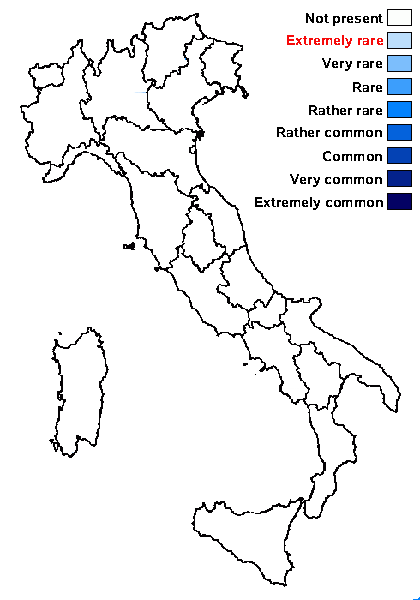Lecanora crozensis Cl. Roux & Poumarat
in Roux & al., Bull. Soc. linn. Provence, 73: 85, 2022
Synonyms:
Distribution:
Description: Thallus crustose, episubstratic, poorly developed, granulose to areolate, pure white but turning yellowish in the herbarium, glossy, forming 0.5-3.5 cm wide patches, without a distinct prothallus, the granules/areoles (0.15-)0.3-1(-1.5) mm wide, orbicular to lobulate. Cortex 20-35 μm thick, with a 5-10 μm thick epinecral layer with numerous small, yellowish crystals and larger colourless crystals, overlaying a 15-25 μm thick paraplectenchymatous layer of more or less anticlinally arranged hyphae, those in the upper part with numerous small crystals, those in the lower part with a few large crystals; algal layer continuous or rarely interrupted; medulla 65-250 μm thick, the upper part dense, subparaplectenchymatous, the lower part consisting of hyphae with elongated cells, with large colourless crystals insoluble in N but soluble in K. Apothecia lecanorine, (0.25-)0.5-0.9(-1.4) mm across, adnate to slightly constricted at base, with a slightly concave to slightly convex, brownish white, dull, epruinose, usually smooth, rarely weakly umbonate disc and a white, 0.05-0.15 mm thick, smooth, finally sometimes wavy, persistent thalline margin. Thalline exciple 100-180 μm thick, corticate, the cortex similar to the thalline cortex, with numerous crystals; proper exciple colourless, 65-110 μm thick, rich in crystals, with a paraplectenchymatous upper part and a prosoplectenchymatous lower part, epithecium yellowish brown, 15-20 μm high, with crystals and granules, the smaller ones yellowish, soluble in K and insoluble in N, the larger ones colourless, soluble in N and insoluble in K; hymenium colourless, 40-50 μm high, I+ blue; paraphyses coherent, simple or sparingly branched and anastomosing, (1-)1.5(-2) μm thick at base, the apical cells 1.5-2.5 μm wide; subhymenium colourless, without crystals; hypothecium colourless 55-75 μm high, with a few small crystals. Asci 8-spored clavate, Lecanora-type. Ascospores 1-celled, hyaline, ellipsoid, (7-)9.5-12(-13) x (4.5-)5.5-7(-7.5) μm, thin-walled. Pycnidia frequent, subglobose. Conidia thread-like, curved to sigmoid, 14.5-24 x 0.5-1 μm. Photobiont chlorococcoid. Spot tests: K-, C-, KC+ faintly yellow, P-. Chemistry: usnic acid and zeorin. Note: a recently-described, silicicolous species found on horizontal to inclined surfaces below the montane belt. Known from France (Drôme); to be looked for in Italy. The description is based on Roux & al. (2022).
Growth form: Crustose
Substrata: rocks
Photobiont: green algae other than Trentepohlia
Reproductive strategy: mainly sexual

Predictive model
Growth form: Crustose
Substrata: rocks
Photobiont: green algae other than Trentepohlia
Reproductive strategy: mainly sexual

Predictive model
 INDEX FUNGORUM
INDEX FUNGORUM
 GBIF
GBIF


